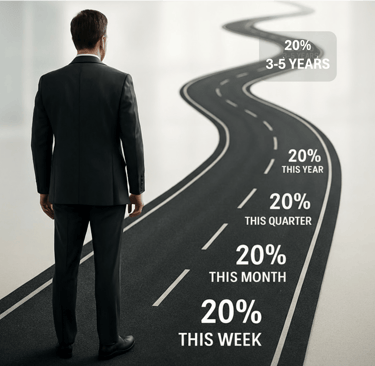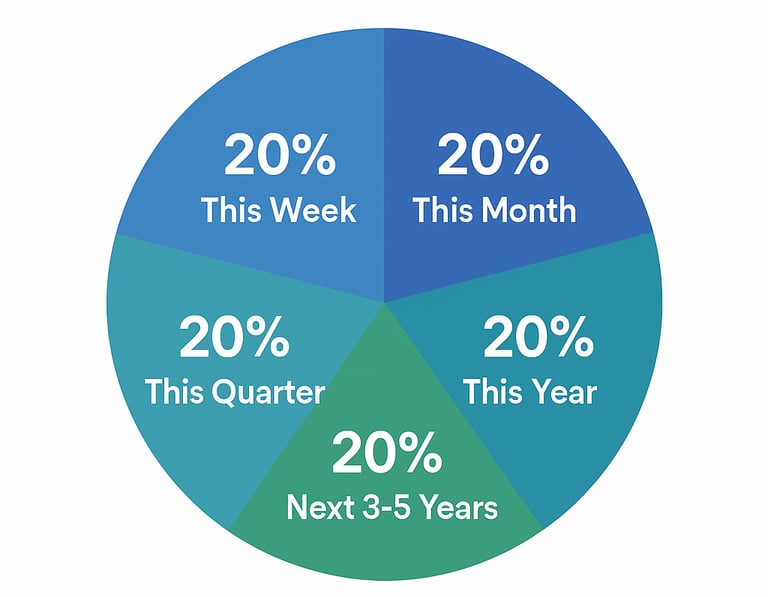The Scope of a Chief Executive
The Scope of a Chief Executive, What a CEO Really Does! Mintzberg Revisited Through the Lens of Time Horizons
11/12/2025


What a CEO Really Does: Mintzberg Revisited Through the Lens of Time Horizons
Everyone has an image of the CEO: the visionary who provides strategic direction, closes deals, gives speeches, and occasionally adjusts the course of the ship with a reassuring smile.
But anyone who looks deeper quickly discovers that the reality is far more chaotic, human, and above all—multifaceted.
Henry Mintzberg, one of the most influential management thinkers of all time, already demonstrated this in the 1970s. His research on “What Managers Do” revealed that managers don’t live linear, well-planned days, but rather navigate a mosaic of brief conversations, rapid decisions, unexpected interventions, and constant information processing.
And yet one key question remains: how does an effective CEO divide their attention, energy, and time?
An elegant answer lies in a simple yet powerful principle—the one you described above:
20% of time devoted to this week, this month, this quarter, this year, and the next 3 to 5 years.
Not as mathematical precision, but as a philosophy.
These two perspectives—Mintzberg’s observations and the 5x20 model—reinforce each other beautifully.
Mintzberg: The Manager as Information Hub, Decision-Maker, and Leader
Mintzberg identified three core managerial roles:
Interpersonal Roles
The CEO as figurehead, leader, and network builder.
Maintaining relationships, building trust, motivating teams—this human side of the job never ends.Informational Roles
Managers act as filters, translators, and distributors of information.
They receive signals from within the organization and the market, process them instantly, and pass them along.Decisional Roles
From strategic choices to crisis management.
The CEO decides, prioritizes, allocates resources, and intervenes when necessary.
Mintzberg’s core message?
Management is fragmented, spares not a single second, and consists of countless micro-decisions.
In short, the reality of a CEO is not a meticulously planned road trip but a continuous dance between urgency and importance.


The 5x20 Model: Creating Order in Chaos
And precisely for that reason, the 20–20–20–20–20 philosophy works so well:
it enforces time hygiene.
20% for this week
This is Mintzberg’s world of interruptions: solving problems, making quick calls, responding to stakeholders, correcting course.
Without this layer, the engine stalls.20% for this month
The realm of operational stability.
Think performance reviews, progress meetings, process improvements, and leadership coaching.20% for this quarter
The bridge between tactics and strategy.
Project portfolios, product launches, commercial campaign cycles, and strategic initiatives live here.20% for this year
This is where vision takes shape.
Budget cycles, strategic planning, partnerships, growth efforts, and investment decisions.20% for the next 3 to 5 years
The CEO as architect of the future.
Where is the market headed? How is technology reshaping the business model? What must the company become?
Mintzberg Would Smile at This Model
Why?
Because it doesn’t pretend that a CEO can perfectly plan their day.
Mintzberg taught us that’s impossible.
But it does provide a balance between the present and the future—between operating and envisioning, between firefighting and future-building.
Mintzberg already showed that effective managers constantly shift between different time horizons, albeit often instinctively.
The 20–20–20–20–20 model makes that instinct explicit, measurable, and manageable.
And perhaps most importantly:
it reminds the CEO not to drown in the present, and not to escape into the distant strategic horizon either.
Both are tempting. Both are dangerous.
The Real Responsibility of the CEO
A CEO who spends 100% of their time in the present becomes a glorified operations manager.
A CEO who lives 100% in the future loses connection with reality on the ground.
The art lies in rhythm.
Mintzberg described it as a dance.
The 20–20–20–20–20 model gives that dance a choreography.
Conclusion
We’ve known since Mintzberg that managers do a lot.
But successful CEOs focus on doing the right things, at the right time, with the right horizon.
The 20–20–20–20–20 model is more than a time allocation framework—
it is a compass.
A way to maintain focus, calm, and direction in a role that is, by definition, chaotic.
Put Mintzberg’s insights beside this model, and you get something truly powerful:
a CEO who stands firmly in the present,
with radar tuned to the future,
and a heart firmly grounded in people.


